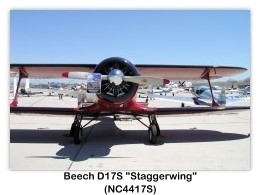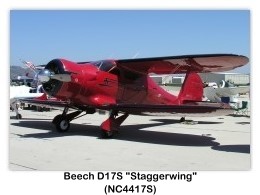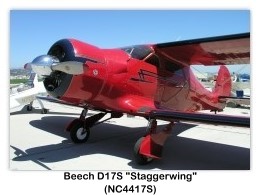
| ||||
|---|---|---|---|---|
 |
 |
 |
 |
 |



























| ||||
|---|---|---|---|---|
 |
 |
 |
 |
 |


























Beechcraft D17S Staggerwing
United States, Five-seat Cabin Biplane
Archive Photos
1943 Beech D17S Staggerwing (N79484) at the 1990 MCAS El Toro Airshow


1944 Beech D17S "Staggerwing" (NC4417S, s/n 6918) at the 2006 Camarillo Air Show, Camarillo, CA



Overview
The Beechcraft Model 17 Staggerwing is an American biplane with an atypical negative stagger (the lower wing is further forward than the upper wing).
Design and Development
At the height of the Great Depression, aircraft executive Walter H. Beech and airplane designer T. A. Ted Wells joined forces to collaborate on a project many considered foolhardy — a large, powerful, and fast biplane built specifically for the business executive. The Beechcraft Model 17, popularly known as the "Staggerwing" was first flown on November 4, 1932, setting the standard for private passenger airplanes for many years to come. It was considered, during its time, to be the premier executive aircraft flying, much as the Gulfstream executive jets are considered in contemporary times.
Assembly line at the beginning of Staggerwing production (note the fixed landing gear). The Model 17’s unusual wing configuration—the upper wing inversely staggered behind the lower—and unique shape resulted in a design that maximized the pilot’s visibility while minimizing the aircraft’s tendency to stall. The fabric-covered fuselage was faired with wood formers and stringers placed over a welded, steel tube frame. The construction of the plane was complex and took many man hours to complete. The Staggerwing’s retractable conventional landing gear, uncommon at that time, combined with streamlining, light weight, and its use of powerful radial engines helped it perform significantly better than other biplane designs.
In the mid-1930s, Beech embarked upon a major redesign of the aircraft, to be known officially as the Model D17 Staggerwing. The D17 featured a lengthened fuselage that improved the aircraft’s landing characteristics by increasing the leverage generated by the elevator. Ailerons were relocated on the upper wings, eliminating any interference with the air flow over the flaps. Braking was improved by the introduction of a foot-operated brake that was synchronized with the rudder pedals. All of these modifications enhanced the Staggerwing’s performance, which would soon be put to the test under wartime conditions.
Operational History
Sales started slowly at first; the first Staggerwings’ high price tag (between US$14,000 and US$17,000, depending on the size of the engine) scared off potential buyers in an already depressed market for civil aircraft. Only 18 Model 17s were sold during 1933, the first year of production, but sales steadily increased. Each Staggerwing was custom-built by hand. The luxurious cabin, trimmed in leather and mohair, could hold up to five passengers. Eventually, the Staggerwing captured a substantial share of the passenger aircraft market. By the start of World War II, more than 424 Model 17s had been sold.
Air Racing
The Staggerwing’s speed also made it the darling of the air racers of the 1930s. An early version of Model 17 won the 1933 Texaco Trophy Race. In 1935, a British diplomat, Capt. H.L. Farquhar, successfully flew around the world in a Model B17R, traveling 21,332 miles (34,331 kilometers) from New York to London, by way of Siberia, Southeast Asia, the Middle East, North Africa and back across Europe.
Louise Thaden and Blanche Noyes won the 1936 Bendix trophy in a Model C17R Staggerwing. Thaden also won the Harmon Trophy for her achievement. Jackie Cochran set a women’s speed record of 203.9 mph, established an altitude record of over 30,000 feet (9,144 m), and finished third in the 1937 Bendix Trophy Race, all while flying a special Model D17W Staggerwing. The aircraft made an impressive showing in the 1938 Bendix race as well.
In 1970 due to a dispute with the T-6 racing class the Reno National Air Races invited five Staggerwings to do a demonstration race. Two G models and two D17 models raced. The five pilots were Bryant Morris, Bert Jensen, Don Clark, Noel Gourselle, and Phil Livingston the only pilot to have prior racing experience in the T-6 Class. The race was flawless with ABC Wide World of Sports Coverage but protesting T-6 racers prevented the class from future competition with spurious allegations of safety issues.
World War II
As World War II loomed on the horizon, a number of Model B17L were pressed into service by the forces of the Second Spanish Republic as bombers during the Spanish Civil War. China ordered a number of Staggerwings to use as ambulance planes in its fight against Imperial Japan. Finland had one B17L as a liaison aircraft between 1940-1945. On October 2, 1941, Beech shipped a special camouflaged D17S to Prince Bernhard of Lippe, who was in exile in London after the Germany invasion of The Netherlands. He used it for refugee work in and around London.
The Beech UC-43 Traveler was a slightly modified version of the Staggerwing. In late 1938, three Model D17S were purchased for evaluation by the United States Army Air Corps for possible use as a light liaison aircraft. These were designated YC-43. After a short flight test program, the YC-43s were sent to Europe to serve as liaison aircraft with the air attachés in London, Paris and Rome.
Early in World War II, the need for a compact executive-type transport or courier aircraft became apparent and in 1942 the United States Army Air Forces ordered the first of 270 Model 17s for service within the United States and overseas as the UC-43. These differed only in minor details from the commercial model. To meet urgent wartime needs, the government also purchased or leased (impressed) additional "Staggerwings" from private owners including 118 more for the Army Air Force plus others for the United States Navy. In Navy service the planes were designated as GB-1 and GB-2. The British Royal Air Force and Royal Navy also received 106 Traveller Mk. I (the British name uses the anglicized double l spelling) through the Lend-Lease arrangement to fill its own critical need for light personnel transports.
The production UC-43 differed in minor details from the service test YC-43. Two distinguishing external features of the UC-43 are the circular ADF antenna mounted between the main landing gear and landing lights near the lower wingtips. They were all powered by the 450 horsepower (336 kilowatt) Pratt & Whitney R-985 engine.
Post-War
After the war’s end, Beech immediately converted its manufacturing capabilities back to the production of civil aircraft with one final version of the Staggerwing, the Model G17S. 16 aircraft were built and sold at a price of US$29,000 apiece. One D17S was sold to Finland from Norway in 1949 and it was used for Finnish Air Force between 1950-1958. The lightweight V-tail Beechcraft Bonanza, a high-powered four-passenger luxury aircraft, soon replaced the venerable Staggerwing in the Beech product line, at about one-third the price. The Bonanza was a much smaller aircraft with much less horsepower, but carried four people with almost exactly the same speed as the Staggerwing. The final Staggerwing was sold in 1948; it left the factory in 1949, the last of 785 aircraft.
Critical Praise
In the April, 2007 issue of AOPA Pilot magazine it was reported that the Staggerwing was voted by nearly 3000 AOPA members as the Most Beautiful Airplane. Members said its the perfect balance between ‘muscular strength and delicate grace’, and they rated it high for its ‘classic lines and symmetry’.
Variants and Design Stages
Production by Model / Model Designation: Number Produced
The Model 17 fixed gear prototype made first flight on November 4, 1932. By 1934, Beechcraft had designed and built four models. They were the 17R (420 hp Wright engine); the A17F (690 hp Wright engine); the A17FS (710 hp Wright engine); and the B17L (225 hp Jacobs engine). All were fixed gear models with the exception of the B17L, which had a pneumatically retractable undercarriage. Of the three models, the B17L proved best suited to meet the market demands, and became the first production model.
Military Designations
Beechcraft Model 17 Engine Selections
Suffix Engine, Radial configuration, Cylinders, Power (hp)
Military Staggerwing Operators
Specifications (Beech Model D17S)
General Characteristics
Performance
References